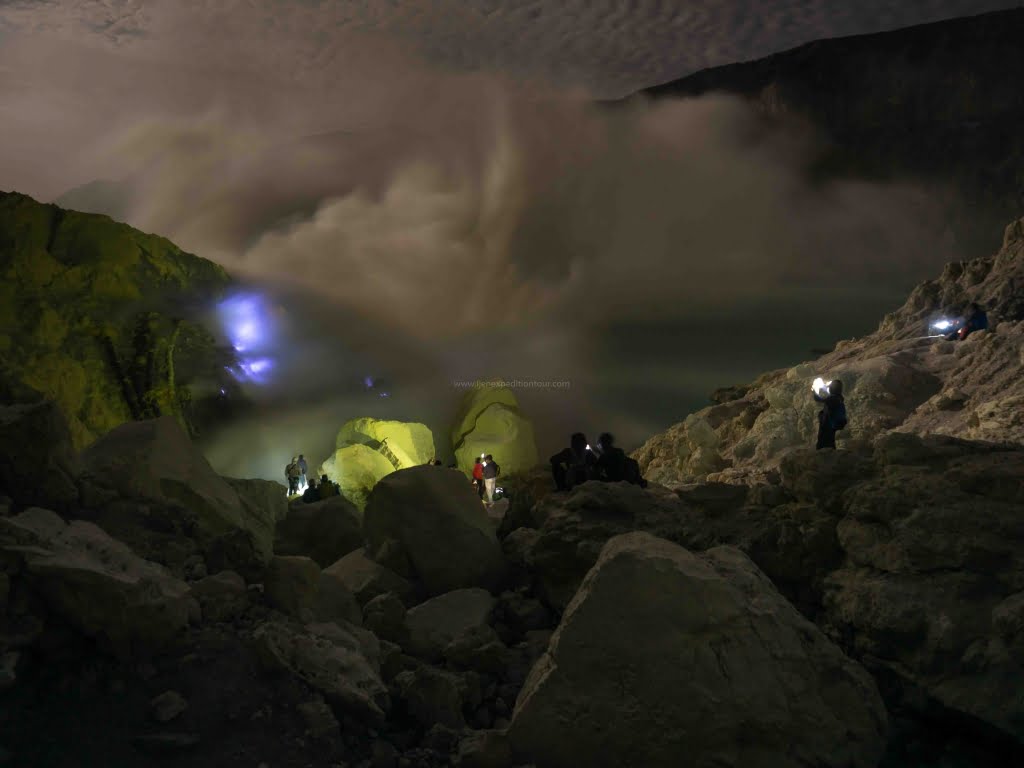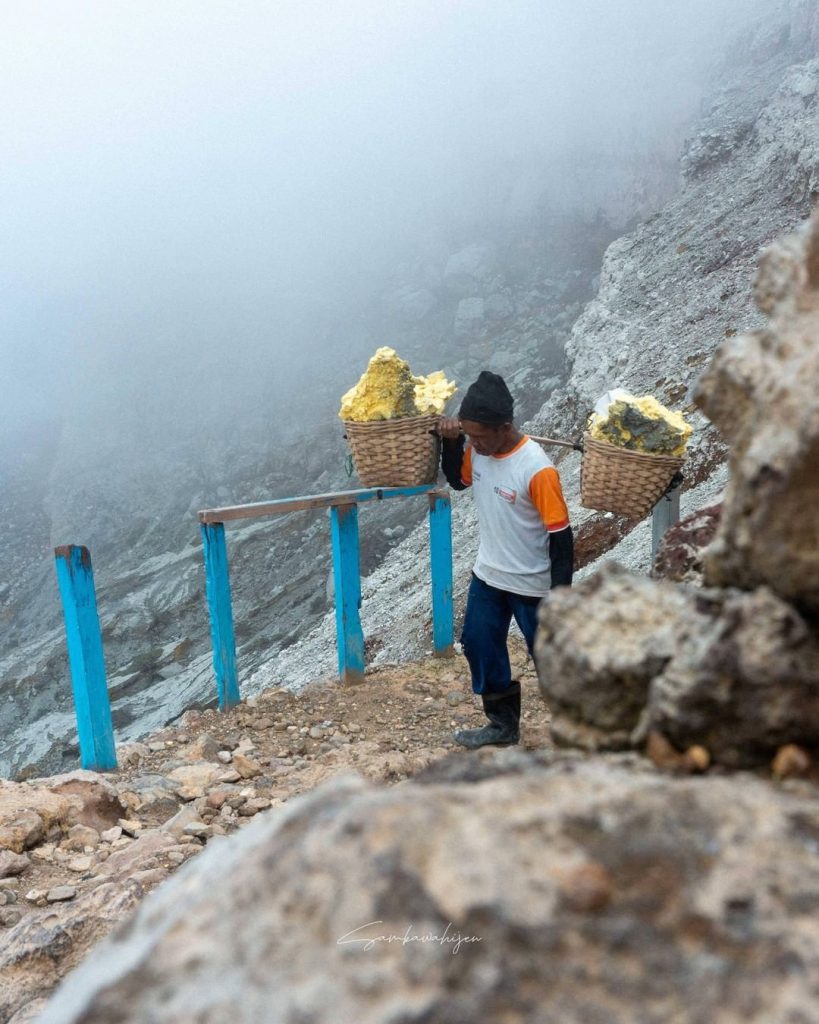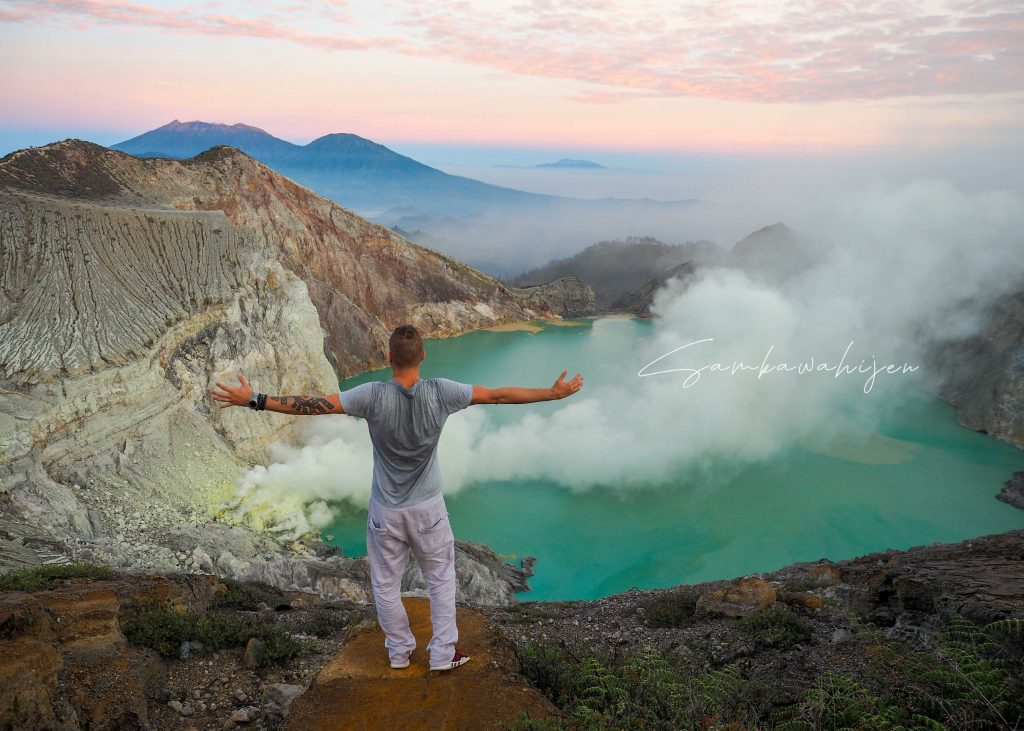Ijen Volcano, on the island of Java, Indonesia has two of the foremost unusual occurrences on Earth. the primary is the active solfatara which provided hot and flammable sulfur gas. It ignites because it enters Earth’s oxygen-rich atmosphere and burns with an electrical blue flame. a number of the gases condense within the atmosphere to supply a stream of liquid sulfur which also burns with electric blue flames. The flames are hard to ascertain during the day but illuminate the view in the dark.

Ijen crater, on the island of Java, Indonesia has two of the foremost unusual occurrences on Earth. the primary is a lively Sulfatara that emitted hot, flammable sulfurous gases. These ignite as they enter Earth’s oxygen-rich atmosphere and burn with an electrical blue fire. a number of the gas condenses within the atmosphere to supply flows of molten sulfur that also burn with an electrical blue flame. The flames are difficult to ascertain during the day but illuminate the landscape in the dark.

The second occurrence may be a one-kilometer-wide caldera lake filled with turquoise-blue water. the color of the water may be the result of its extreme acidity, and high concentration of dissolved metals. it’s the world’s largest holy acidic lake with measured a ph as low as 0.5. The explanation for its acidity is an inflow of hydrothermal waters charged with gases from a hot magma chamber below.
Sulfur Deposits | Ijen Volcano
The continuous stream of sulfur-laden gases blasts from fumarole at the lake-side solfatara. These hot gases travel underground in the absence of oxygen. If they’re hot enough once they emerge from a vent, the sulfur ignites upon contact with oxygen within the atmosphere. Often the temperature is low enough that the sulfur condenses, falls to the bottom as a liquid, flows a brief distance, and solidifies. This produces a renewable deposit of mineral sulfur that local people mine and carry to an area refinery that buys it.

Sulfur Mining | Ijen Volcano
Miners walk up the flank of the mountain and then descend dangerous rocky paths down the steep walls of the caldera. Then, using steel bars, they break sulfur from an outcrop, load their baskets, and make the return trip to the refinery. Miners make one or two trips per day carrying up to 200 pounds of sulfur. The refinery pays them based on the load of sulfur that they deliver.
the speed of pay amounts to some dollars per trip. Ambitious and physically fit miners can make two trips per day.
Miners have carried many sections of pipe up the mountain. These are wont to capture the gases produced by numerous vents and route them to one area where their sulfur spills onto A level work area. This makes the collection more efficient and safer for the miners.

Sulfur mining at Ijen Volcano has its hazards. The steep paths are dangerous, the sulfur gases are poisonous, and occasional gas releases or phreatic eruptions have killed many miners.
Ijen Crater is one of the few locations on Earth where sulfur remains produced by artisanal miners. Today, most of the world’s sulfur is produced as a byproduct of oil refining and gas processing. Nearly 70 thousand metric tonnes of sulfur are produced by these methods. A coincidence of low wages and a little local demand for brimstone supports artisanal mining at Kawah Ijen.

Volcanic History
About 300,000 years ago, volcanic activity in this area began building an outsized stratovolcano that’s called “Old Ijen” today. Over thousands of years and repeated eruptions, it grew to an elevation of about 10,000 feet. Lava flows and pyroclastic deposits from Old Ijen disconformably overly the Miocene limestone.
Then, about 50,000 years ago, a series of enormous explosive eruptions produced a caldera about ten miles in diameter. About twenty cubic miles of fabric was ejected and covered the encompassing landscape up to 300 to 500 feet deep in ejecta and volcanic ash.
In the past 50,000 years, many small stratovolcanoes have formed within Old Ijen’s caldera and covered its southern and eastern margins. Kawah Ijen covers a part of the eastern margin. Thousands of years of weathering have converted the pyroclastic deposits into rich, fertile soils which now support coffee plantations.
The volcano remains active. The last magmatic eruption occurred in 1817. Phreatic eruptions occurred in 1796, 1917, 1936, 1950, 1952, 1993, 1994, 1999, 2000, 2001, and 2002. These have caused little or no damage but present a danger to anyone mining sulfur or visiting the caldera.

Acidic Streams Below the Caldera
Water enters the caldera lake as rain and as runoff from a limited catchment area. Water and gases also enter through hydrothermal vents on the rock bottom of the lake. Rarely, overflow water goes over a spillway on the side of the lake and into the Banyupahit River catchment area. “Banyupahit” may be a local word meaning “bitter water.”
Water also leaves the lake through underground seepage and enters tributaries of the Banyupahit River. As this water enters the catchment area, it’s a pH and dissolved metals content almost like the caldera lake.
because it flows downstream, it’s diluted by runoff and comes from sources that aren’t influenced by hydrothermal activity. These waters raise the pH of the river, add oxygen, and cause dissolved metals to precipitate out into the stream channel. this is often a source of natural pollution that degrades the catchment area, the sediments, and lowers the standard of water which will be withdrawn for irrigation use.
The best time to visit Ijen Crater Or ijen Volcano Or Kawah Ijen
The best day to visit this volcano is the dry season, which mostly it starts from April until the beginning of November. Those months are the best time to visit Ijen Crater.
WORST TIME TO VISIT: Start from the end of December until March, there will be more rain that will start from Morning until night. From December until March, the intensity of the fog in the Ijen Crater was lower. Thus, visitors can see the blue lake and blue fire without being blocked by fog.
What you can see in the Ijen Volcano
1. The blue fire phenomenon
The blue fire is a natural wonder that can only be seen at Ijen, It is only visible in the extreme darkness. If you are planning to witness the blue fire, you have to start walking at 2 AM. Once at the top you have to descend again into the crater, wearing a mask to find the blue fire.

2. Acidic Crater Lake
This beautiful warm lake with its blue-greenish water looks very inviting but it is corrosive and dangerous! Kawah Ijen (Ijen crater) is the world’s largest highly acidic volcanic lake. The crater size is about 960 meters x 600 meters with a depth of 200 meters is so acidic that it can dissolve clothes and human flesh.
The acid measure is almost zero (pH<0.5) similar to the strength of car battery acid. I tried to touch the water using my finger, it was very warm and tasted salty.

Please don’t try this, I got my finger itched for about 30 minutes! The best time to go down to Ijen crater lake is in the morning between 4.00 to 9.00 am. Around 10 am the wind started to blow the acid smokes of sulfur to the walking path.
It will be hard to climb down or up when it got covered with those sulfur smokes. If you are in this situation and you don’t have a mask, pour some water on the tissue or handkerchief.
2. Sunrise

2. Sulfur miner
Kawah Ijen has been a working sulfur mine since 1968 and you will come across many hardworking miners hauling heaving reed baskets of sulfur—weighing up to a mind-boggling 200 pounds—up and down the volcano on your hike.
In what has to be one of the toughest jobs in the world, many miners choose this line of work over farming in local areas thanks to its higher wage: roughly $10 a day (around 800 rupiahs per kilogram, based on two trips).

Tips for Visiting Ijen Volcano
Because the area is in the form of mountains, there are some things you need to prepare before visiting Ijen Crater. Anything? Let’s see the list.
- warm cloth
- scarves and jacket
- exercise
- respirator mask and goggles










[…] Ijen Sulfur miner | everyday load of guys climbs 9,000 feet to the summit of mount ijen positioned in java, Indonesia after which trek 3,000 ft down into the crater to break slabs of sulfur. Each load of sulfur is around one hundred-a hundred and thirty-five pounds, that’s the approximate overall frame weight of the miners. […]
[…] using this supply of global trends like a domestic passenger waiting rooms (14 m2/orang) and international (20 m2/orang). As an entire, the airport […]
[…] The acid measure is almost zero (pH<0.5) similar to the strength of car battery acid. I tried to touch the water using my finger, it was very warm and it tastes salty. […]